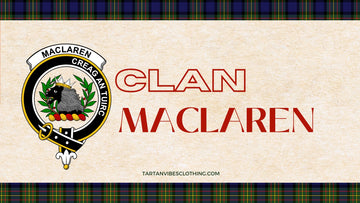Clan MacLaren: History, Origins & Tartan of a Scottish Clan
by Teejay Smith on Apr 01, 2024
Table of Content
Nestled amidst the majestic landscapes of Scotland, Clan MacLaren boasts a rich history interwoven with the rugged beauty of the region. From their ancestral lands in Balquhidder and Strathearn to their unwavering spirit through centuries of change, the MacLarens have left an indelible mark on the Scottish tapestry. Uncover the captivating story of Clan MacLaren, shedding light on their origins, legendary battles and vibrant culture that continues to thrive today.
Origins of Clan MacLaren
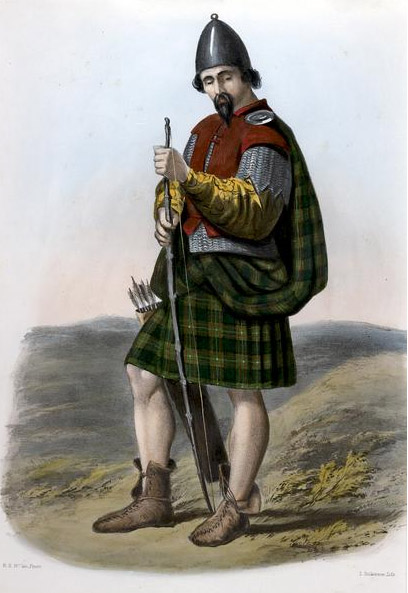
The origins of Clan MacLaren, a proud Scottish Highland clan, are shrouded in legend. Two main theories attempt to explain their ancestry:
- Descent from Lorn (Traditional Account): This popular belief traces the clan's lineage back to Lorn, son of Erc, who arrived in Argyll around 503 AD. However, concrete evidence directly linking Lorn to the MacLarens remains elusive. Interestingly, the clan's Gaelic name, "Clann mhic Labhrainn," doesn't directly connect to Lorn.
- Descendants of Abbot Laurence (Gaining More Traction): This theory is considered more credible and places the clan's origin with a 13th-century abbot named Laurence. Laurence, Abbot of Achtow in Balquhidder, is believed to be the clan's founder. This aligns with the clan's rallying cry, "Creag an Tuirc" (Boar's Rock), which stands near Achtow. The clan's heraldry also suggests a possible connection to a cadet branch of the Earls of Strathearn.
Territory of Clan MacLaren
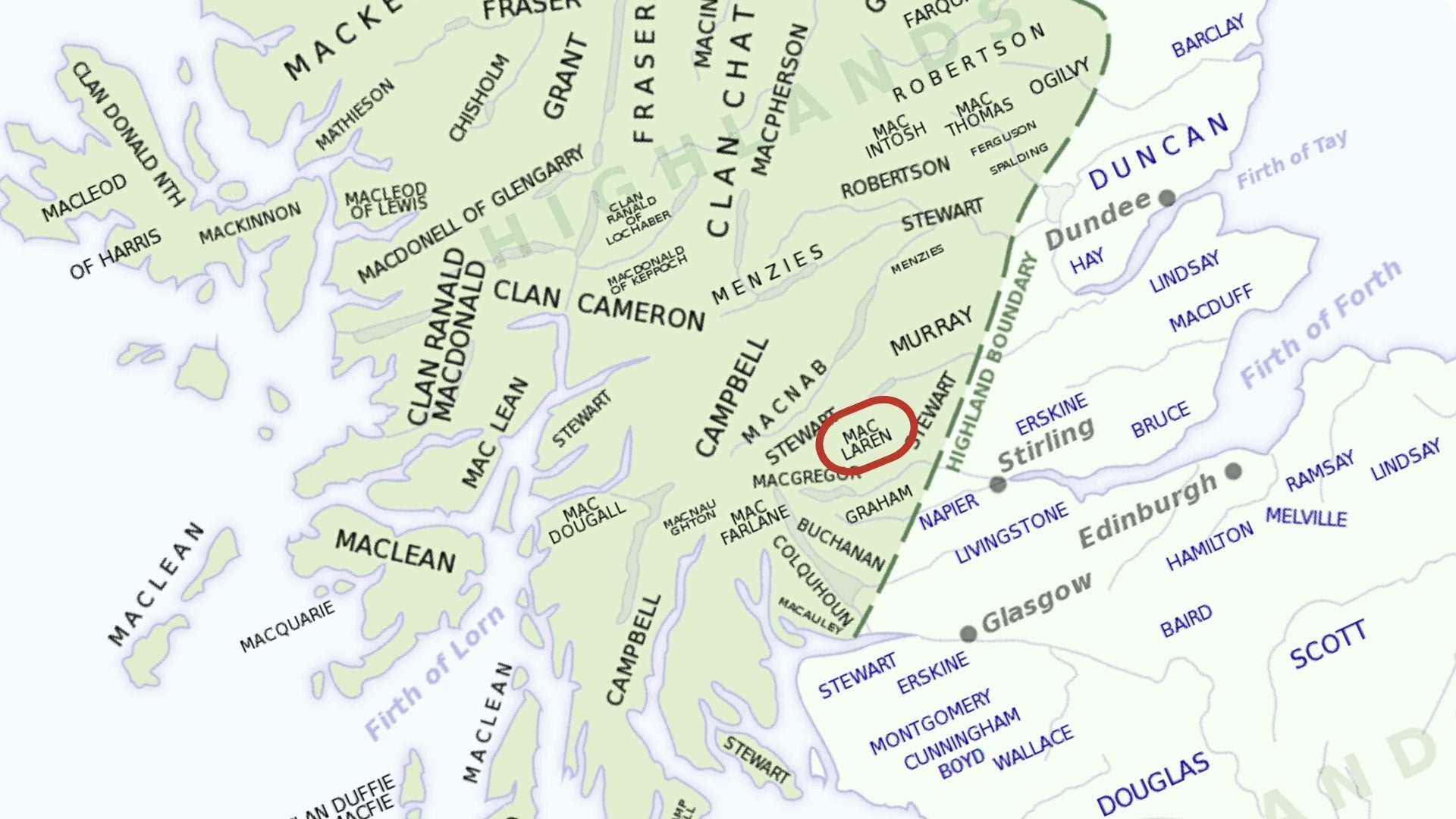
The traditional territory of Clan MacLaren is located in Perthshire, Scotland, specifically in the area around Balquhidder. This region encompasses the villages of Lochearnhead and Strathyre, stretching for roughly 18 miles (29 km) long and 7 miles (11 km) wide, totaling approximately 54,675 acres (22,126 hectares). This area was historically known as "Maclaren Country".
Clan MacLaren History
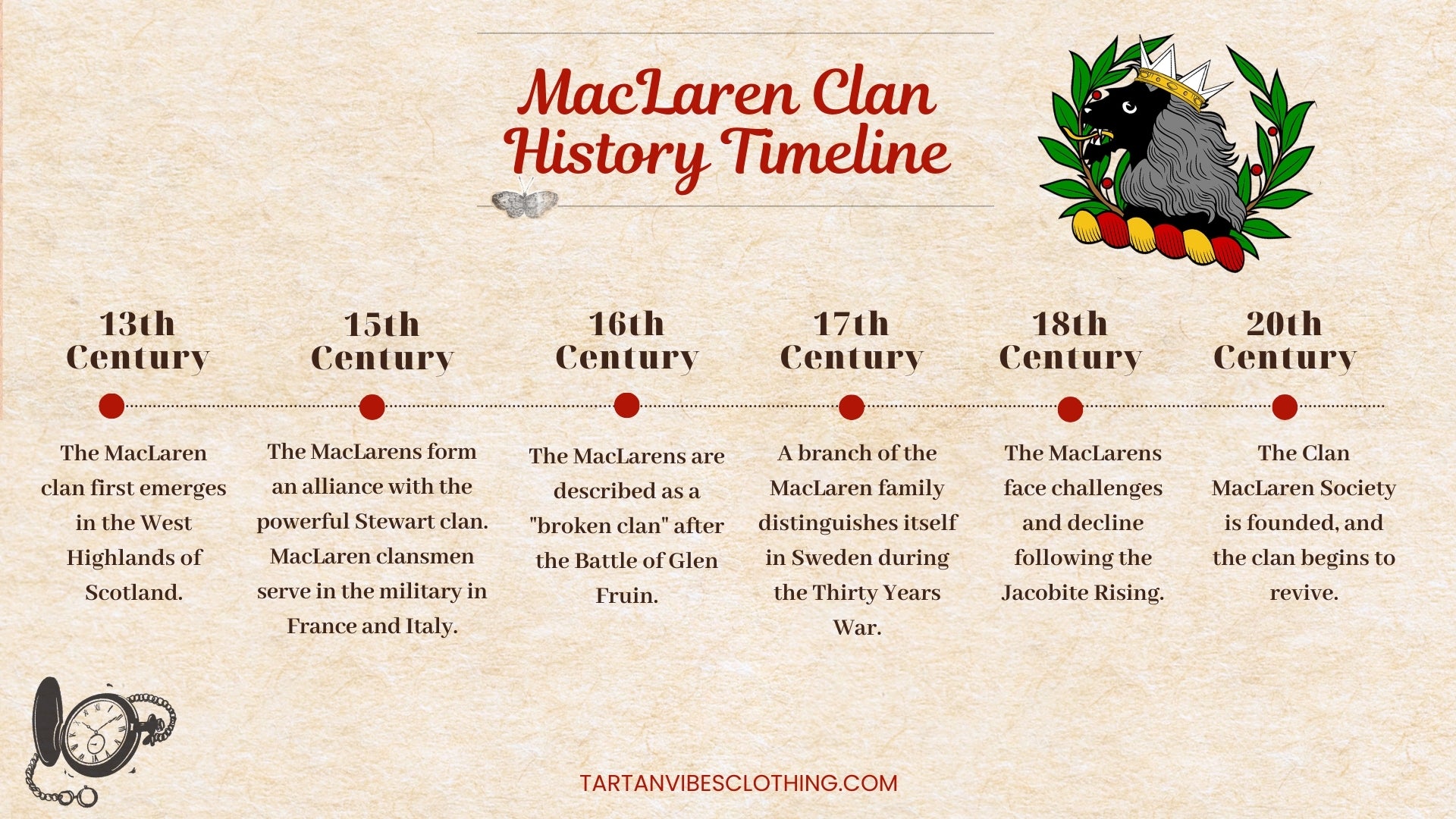
Early History (13th - 15th Centuries)
Clan MacLaren first emerged in the 13th century, associated with the lands of Balquhidder and Strathearn in the West Highlands of Scotland. The name "MacLaren" originates from "Labhran," the name of Abbot Laurence, a prominent figure in the Achtow area of Balquhidder. Led by chieftains, the MacLarens grew into a powerful clan, involved in various wars and conflicts in the region.
Rise and Alliance (15th - 17th Centuries)
In the 15th century, the MacLarens allied with the powerful Stewart Clan, strengthening their position and expanding their influence. This strategic alliance was cemented when a daughter of the MacLaren family married a Stewart Lord of Lorne in the fifteenth century. Their first son, Dougal, became the progenitor of the famous Stewarts of Appin.
A notable achievement was the victory against the MacGregors at the Battle of Glen Fruin in 1603, defending MacLaren's territory and reputation. Clan MacLaren played a significant role in the Scottish Civil War, supporting the Royalist cause.
Challenges and Decline (18th - 19th Centuries)
Following the defeat of the Royalists in the Jacobite Rising of 1745, the MacLarens faced significant repercussions. The clan was forced to sell parts of their lands due to war consequences and harsh laws imposed on the Scottish people. However, the MacLarens maintained their identity and sense of community, overcoming various hardships and continuing to thrive.
Global Impact and Transformation (15th - 19th Centuries)
While some Clan MacLarens remained in Scotland, the clan's influence extended beyond its borders. By the end of the fifteenth century, many MacLaren clansmen had emigrated to serve with the military in France and Italy, demonstrating their martial spirit.
Interestingly, a branch of the family distinguished itself in Sweden by the time of the Thirty Years War, showcasing the global reach of the MacLaren name. The modern Swedish writer Carl G. Laurin is one of many who carry the clan name in Scandinavia.
Revival and Modernity (20th Century - Present)
The 20th century saw the revival of the MacLaren clan, regaining their position and influence within the community. The Clan MacLaren Society was established, connecting members worldwide. Today, the MacLarens are a vibrant clan, preserving their traditions, culture and organizing various activities for members.
Clan MacLaren: Chiefs and Notable Figures
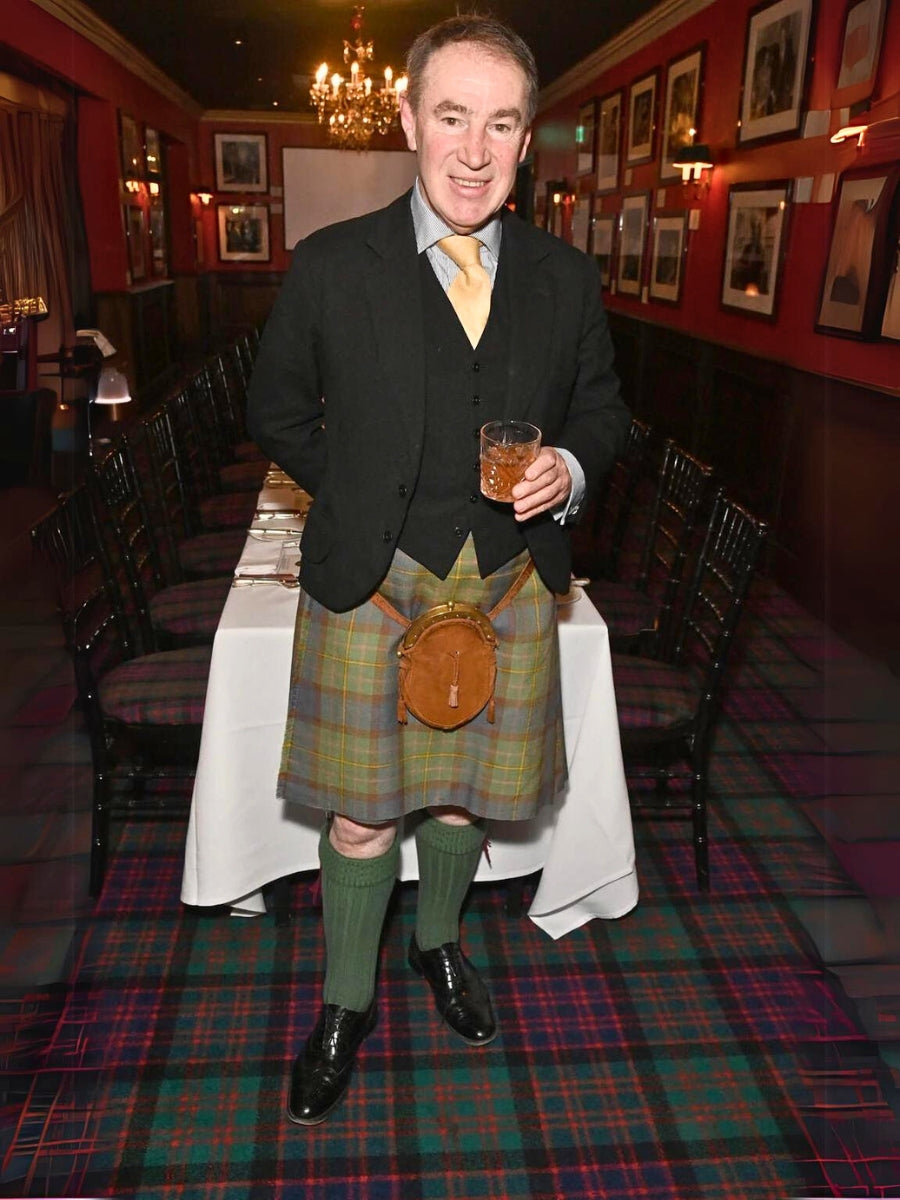
After the passing of Chief of Clan MacLaren Donald MacLaren (pictured), his son Florian will take over as chief. Donald had a long-lasting and impressive career with the British Foreign Service but is now retired. He lived with his wife and five children at their Kirton Farm in Balquhidder Glen. The property includes Creag an Tuirc, a scenic hill that overlooks the village. This hill was the ancient rallying point of the Clan.
Historical Figures:
Abbot Laurence (13th Century): Believed to be the eponymous founder of the clan, associated with the lands of Achtow in Balquhidder.
John MacLaren, Laird of Balquhidder (16th Century): Knighted by King James IV of Scotland, signifying the clan's rise in prominence.
Captain Donald MacLaren of Invernentie (18th Century): A Jacobite rebel who fought at the Battle of Culloden and made a daring escape from imprisonment in Stirling Castle.
Professor Colin MacLaren (18th Century): A distinguished mathematician from a Tiree branch of the clan.
Clan MacLaren Coat of Arms
A badge of honor and heritage, the Clan MacLaren coat of arms serves as a powerful symbol of the clan's identity and core values.
Central Elements and Significance:
Crowned Lion's Head: Representing strength, courage, and leadership, the lion is a prevalent symbol in heraldry. The crown further emphasizes MacLaren's position of authority and nobility.
Laurel Branches: Encircling the lion's head are laurel branches, signifying victory, honor, and triumph. These branches celebrate the clan's achievements and resilience throughout history.
Motto: "Creag an Tuirc" (Gaelic for "Rock of the Boar") This powerful motto speaks to the unwavering determination and steadfastness of Clan MacLaren. The "Rock" symbolizes a place of refuge and resilience, while the "Boar" represents bravery and ferocity.
Clan MacLaren Crest
Gaelic Name: MacLabhruinn
Crest: A lion’s head erased Sable crowned with an antique crown of six (four visible) points Or, between two branches of laurel issuing from the Wreath at either side of the head, both Proper
Motto: Creag an Tuirc (The boar’s rock)
Origin of Name: Gaelic, ‘Son of Laurence’
Badge: Laurel
Lands: Perthshire
Clan Chief: Donald MacLaren of MacLaren
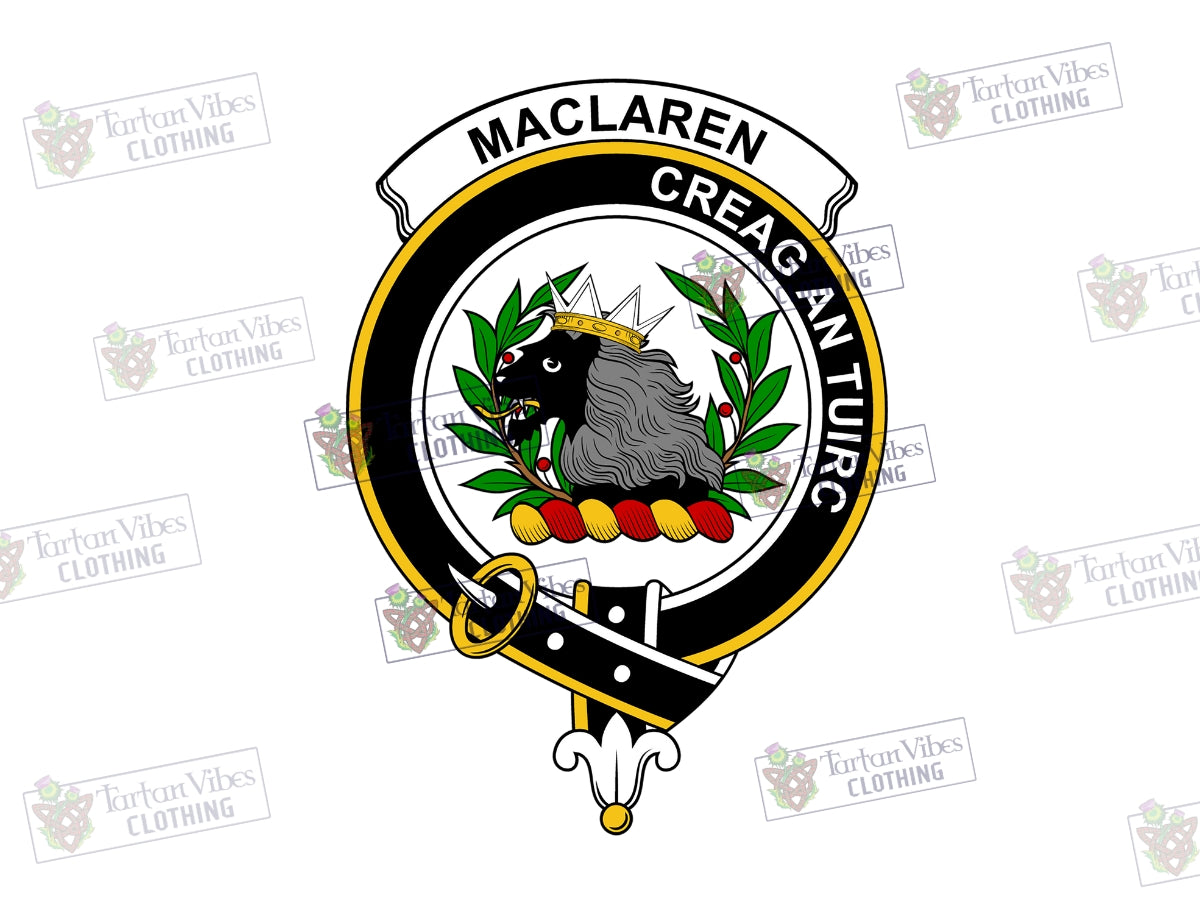
The Clan MacLaren crest is a powerful symbol that embodies the clan's core values of strength, courage, and leadership.
Description:
The crest features a crowned lion's head. The lion is depicted as "erased" (meaning cut off cleanly at the neck) and facing the viewer (also known as "rampant").
Atop the lion's head sits a closed crown, signifying nobility and authority.
Symbolism:
The lion is a prevalent symbol in heraldry, representing strength, courage, and leadership. These qualities were highly valued by warriors and leaders throughout history, and the lion embodies the fierce spirit associated with Clan MacLaren.
The closed crown further emphasizes the clan's position of nobility and potential historical connection to royalty or positions of authority.
Clan MacLaren Tartan
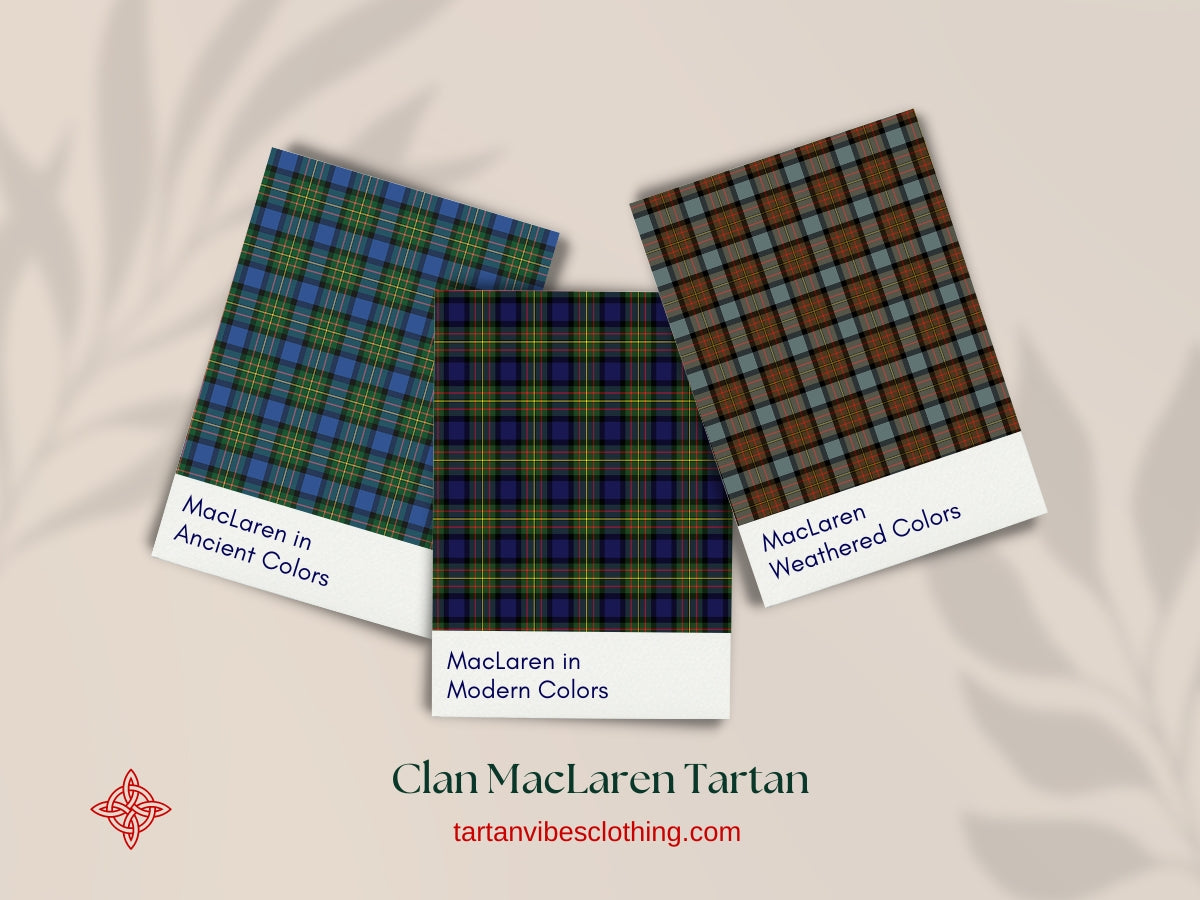
The Clan MacLaren boasts a rich tapestry of tartans, each a unique expression of the clan's heritage and shared identity. Here, we delve into the most prominent MacLaren tartans and their symbolic meanings:
Variations Steeped in Tradition:
Ancient MacLaren Tartan: Believed to be the oldest, this tartan features a muted yet dignified palette of dark green, black, red, and yellow.
Modern MacLaren Tartan: A vibrant evolution of the Ancient, the Modern Tartan features more prominent red and yellow threads, making it the most popular choice today.
Weathered MacLaren Tartan: A variant of the Modern, this tartan evokes a sense of history with its "faded" or "weathered" appearance, achieved through muted tones.
Dress MacLaren Tartan: This formal version of the Modern Tartan features wider stripes and a luxurious look, perfect for special occasions.
A Language of Colors:
Beyond aesthetics, the colors in each MacLaren tartan hold deep meaning:
Green: Symbolizes the verdant landscapes of Scotland, a cornerstone of Highland culture and the clan's roots.
Black: Represents stability, resilience, and the unwavering strength of the Clan MacLaren.
Red: Evokes the courage and bravery that have defined the clan throughout history.
Yellow: Hints at the potential connection to royalty and a prosperous future for Clan MacLaren.
A Symbol of Belonging:
Wearing a Clan MacLaren tartan is more than just adorning fabric; it's a powerful symbol of heritage. It's a way for members to connect with their ancestors, express pride in their lineage, and celebrate their shared identity. Furthermore, anyone with Scottish ancestry or a deep appreciation for Clan MacLaren's history and traditions can wear these tartans with respect.
The Clan MacLaren tartans, much like the vibrant history they represent, offer a captivating glimpse into the enduring spirit and unwavering pride that define this remarkable clan.
In contrast to the vibrant colors of the MacLaren tartan, the Clan Buchanan tartan presents a captivating tapestry woven with a distinct elegance. This unique color palette, often featuring deep blues, rich greens, and flashes of red, reflects the rugged beauty of the clan's ancestral homeland – the Loch Lomond region. The blues evoke the serenity of the loch's waters, while the greens represent the lush, rolling hills that surround it. The flashes of red add a touch of vibrancy, symbolizing the clan's unwavering spirit and courage throughout history. The Buchanan tartan stands as a powerful symbol of the clan's heritage, its colors echoing the breathtaking landscape that shaped their identity.
Explore the timeless traditions of the MacLaren Clan through our collection of tartan products on our website. And bring a piece of the clan's history into your present.
The Clan MacLaren Society
Uniting the Clan Worldwide:
Formed in 1972, the Clan MacLaren Society unites MacLarens across the globe. With branches in North America, Scotland and New Zealand, the society fosters a sense of community and belonging for clan members.
Preserving a Proud Heritage:
The society plays a vital role in preserving the clan's rich history and traditions. They organize annual gatherings, known as "MacLaren Days", where members celebrate their shared heritage through music, dance, storytelling, and competitions. The society also supports genealogy research and education, ensuring the clan's legacy thrives for future generations.
Conclusion
Clan MacLaren's story, etched across the fabric of Scottish history, is one of unwavering spirit and enduring strength. From their ancestral lands in Balquhidder and Strathearn, the MacLarens have consistently embodied the resilience and courage that define the Scottish character. Their unwavering presence through centuries of change serves as a testament to their enduring legacy.
Today, the vibrant Clan MacLaren community thrives across the globe. Bound by a shared ancestry and a deep respect for their forebears, clan members actively contribute to their communities while proudly upholding the traditions that have shaped their identity for generations. Their enduring spirit ensures that Clan MacLaren's legacy will continue to inspire future generations, reminding us of the power of unity and the enduring strength of Scottish heritage.
Frequently Asked Questions
Where is the MacLaren clan from?
Maclaren Clan is thought to come from the Argyll area and descended from Lorn, son of Erc in 503. But other recordings from the 12th century show the family line comes from Perthshire.
What are the colors of the Clan MacLaren ?
Their tartan features dark green, navy, yellow, red, and black. Scouts adopted it in 1921, honoring William de Bois Maclaren.
Who is the clan chief of MacLaren?
Following his death in 1966, Donald MacLaren was succeeded by his son of the same name, Donald MacLaren, who is the current Clan Chief. Donald went to schools in Oxford and Perthshire, where he learned to play the pipes, and later attended the University of Edinburgh, where he took a MA Hons.
What is the Clan MacLaren family motto?
The MacLaren clan motto is "Creag an Tuirc" (The boar's rock) and the clan crest is a lion's head with a crown, surrounded by laurel branches.

